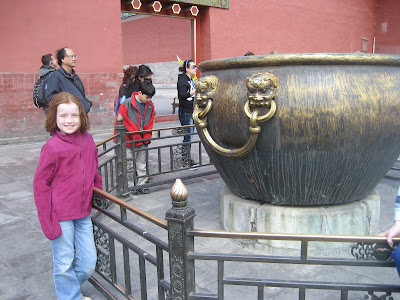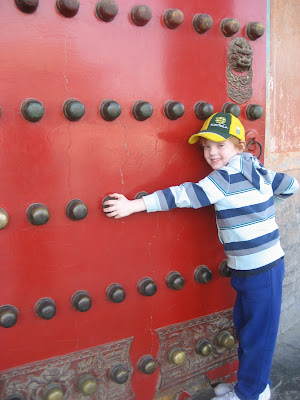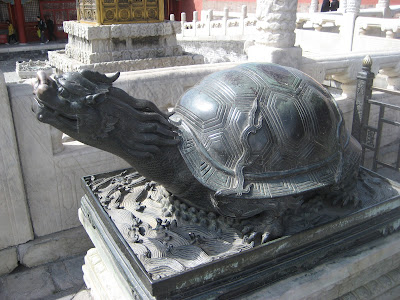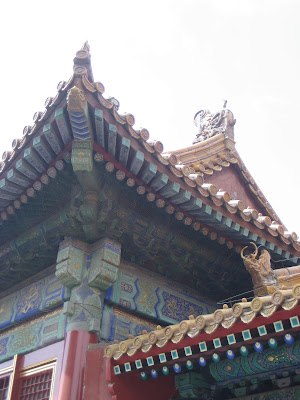We started our explorations today at Zhengyangmen Gate also known as the Front Gate (or “Qianmen” in Chinese), located at the south end of Tiananmen Square.
Right in front of Zhengyangmen is the arrow tower.
We went inside Zhengyangmen to look at some of the exhibits.
This view of Tiananmen Square shows the Great Hall of the People. I confess I really didn't know much about Tiananmen before coming here, except about the massacre of the students that happened in 1989.
We were surprised by the airport level security when entering the square, with x-ray machines and a high level of police presence. Tirzah and I were even banned from entering Mao’s Mausoleum, as I had a camera in my pocket. Here she is posing in front of the Monument to the People's Heroes
Most of the tourists in the Square appeared to be Chinese people, not foreigners. They descended upon our kids and repeatedly asked to pose with them for photos. This was fun for the first twenty-or-so times.
This was our first view of the red walls of the Forbidden City.
The Forbidden City is now officially known as the Palace Museum. It was built by the third Ming Emperor, Yongle, who moved the capital of China from Nanjing to Beijing about 600 years ago. It then became the central political seat and home of the government of the Ming and the Qing Dynasties for the next 500 years. The Forbidden City is divided into the Outer Courtyard and the Inner Courtyard. There are three large halls, the Hall of Supreme Harmony, the Hall of Middle Harmony and the Hall of Preserving Harmony used by emperors for public ceremonial purposes. There are also three large palaces, the Palace of Heavenly Purity, the Hall of Union and Peace, and the Palace of Earthly Tranquility. Believe it or not, there are almost 1000 buildings in The Forbidden City with almost 9000 rooms.
All of that to say, the place is ENORMOUS and I regret to inform you that I did not keep track of which photo is of which particular hall or palace.
With our three young children in tow, you can imagine that we did not dawdle to admire the rich colours and amazing architecture for overly long.
We saw many bronze vats all around the halls and palaces for storing water to fight fires since the structures in the Forbidden City were built mainly with wood. In winter, these vats were constantly heated to make sure that they didn’t freeze.
Animal ornaments decorate the corners of many roofs in the palace. Apparently, more animals signified a more important building.
Our children amused themselves (and many others!) by sliding down the steps of the halls.
A pair of lions guards the entrances to the halls and palaces. This female lion plays with her cub which symbolises imperial fertility.
All the gates in the Forbidden City are decorated with a nine-by-nine array of golden studs as nine is considered lucky.
After the heat of the courtyards, I was impressed by the cooler Imperial Garden which is composed of ancient cypress trees and elaborate stone landscapes.
Jemilla liked this juniper tree which was purposefully shaped into the Chinese character "ren" (human being).
We are very glad we had the opportunity to visit these important historical and cultural landmarks in Beijing. However, it remains to be seen whether the children will remember much about the experience other than walking around all day and looking at "old buildings".






















































Wonderful photos and a memorable experience BUT I still remember the Chinese refugees we knew in Abidjan and especially their stories.Hmmmmm.
ReplyDeleteWOW! It looks really interesting. I have a Chinese assignment (because I learn Chinese at school) and we have to list historical sights in Beijing. This has given me a lot of information so thanx. Oh I'm just wondering Jemilla, do you learn mandarin or Cantonese at school (I think I spelt that wrong and I'm not trusting the dictionary because it said that your name was spelt wrong). I learn Mandarin but I don't know very much!
ReplyDeleteBrianna, the children have Mandarin lessons at school every day. Most people in Hong Kong, however, speak Cantonese.
Delete